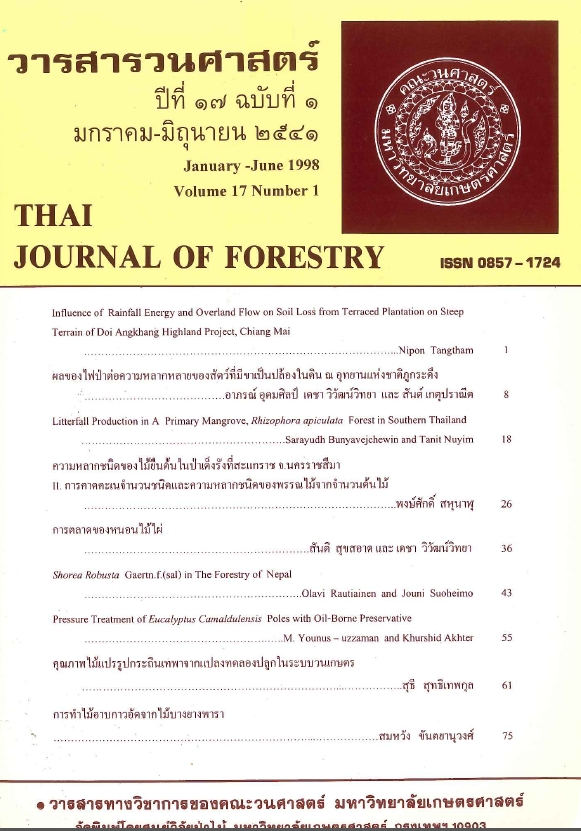PRESSURE TREATMENT OF EUCALYPTUS CAMALDULENSIS POLES WITH OIL - BORNE PRESERVATIVE
Main Article Content
บทคัดย่อ
Eucalyptus cumaldulensis poles were treated with 50 : 50 creosote light diesel oil mixture, The pole size round E. camaldulensis was found to contain an average of 53.85 % sapwood, which is readily persihable by wood destroying organisms. Eucalypt poles were treated by the Bethel Full-Cell process using varying pressure and duration to evaluate the effect on penetration and retention of the preservative mixture. It was found that with the increase of both treating pressure and time, the increase in penetration was not found to be statistically significant. Only treating pressure had highly significant effect on increasing the retention of preservative in the sapwood. The coefficient of variations of penetration and retention within the individual poles and the same between the poles were calculated. A penetration of 3.5 cm with retention of 318.45 kg / m3 in the treated sapwood could be obtained by using 10.57 kg / cm2 pressure for 3 hrs. This penetration is considered adequate to protect the sapwood region of the pole.
Downloads
Article Details

อนุญาตภายใต้เงื่อนไข Creative Commons Attribution-NonCommercial-NoDerivatives 4.0 International License.
ข้าพเจ้าและผู้เขียนร่วม (ถ้ามี) ขอรับรองว่า ต้นฉบับที่เสนอมานี้ยังไม่เคยได้รับการตีพิมพ์และไม่ได้อยู่ในระหว่างกระบวนการพิจารณาตีพิมพ์ลงในวารสารหรือสิ่งตีพิมพ์อื่นใด ข้าพเจ้าและผู้เขียนร่วม (ถ้ามี) ยอมรับหลักเกณฑ์และเงื่อนไขการพิจารณาต้นฉบับ ทั้งยินยอมให้กองบรรณาธิการมีสิทธิ์พิจารณาและตรวจแก้ต้นฉบับได้ตามที่เห็นสมควร พร้อมนี้ขอมอบลิขสิทธิ์ผลงานที่ได้รับการตีพิมพ์ให้แก่วารสารวนศาสตร์ คณะวนศาสตร์ มหาวิทยาลัยเกษตรศาสตร์ กรณีมีการฟ้องร้องเรื่องการละเมิดลิขสิทธิ์เกี่ยวกับภาพ กราฟ ข้อความส่วนใดส่วนหนึ่ง หรือ ข้อคิดเห็นที่ปรากฏในผลงาน ให้เป็นความรับผิดชอบของข้าพเจ้าและผู้เขียนร่วม (ถ้ามี) แต่เพียงฝ่ายเดียว และหากข้าพเจ้าและผู้เขียนร่วม (ถ้ามี) ประสงค์ถอนบทความในระหว่างกระบวนการพิจารณาของทางวารสาร ข้าพเจ้าและผู้เขียนร่วม (ถ้ามี) ยินดีรับผิดชอบค่าใช้จ่ายทั้งหมดที่เกิดขึ้นในกระบวนการพิจารณาบทความนั้น”


